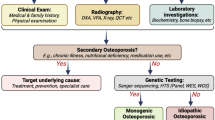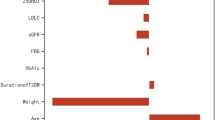Abstract
Osteoporosis is a major public health problem, particularly in women. Bone mineral density (BMD) reference plot is a basic, and the peak BMD (PBMD) an important, parameter in the diagnosis of osteoporosis. In order to establish reference plots of BMD at multiple skeletal sites in Chinese women and improve the diagnostic accuracy for osteoporosis, we measured BMDs at several skeletal regions in 3,378 Chinese women, aged 5–96 years, using a dual-energy X-ray absorptiometry fan-beam bone densitometer. After determining that the cubic regression model best fit all skeletal regions, we utilized the curve-fitting to establish BMD reference plots and utilized the curve-fitting equation to calculate the highest BMDs at all skeletal regions using three different methods of calculation—actual PBMD (method A), PBMD of each 5-year age group (method B), and a cross-section of age (method C). When the three methods were compared, we found significant differences among them at the majority of skeletal regions studied. When we utilized these three methods to determine the prevalence of osteoporosis in 2,120 women aged 40 years and older, except for the Ward’s triangle, we observed significant differences among them at all skeletal regions. In the present study, we established new BMD reference plots at multiple skeletal regions for women of mainland China. Our findings also indicate that curve-fitting equations can be employed to calculate actual PBMDs specific to individual regions, and that the use of different methods to calculate PBMD may have a significant impact on both PBMD and the diagnosis of osteoporosis. Therefore, we suggest that a standardized method be established to calculate site-specific PBMDs based on the peak values of best-fit reference curves in appropriate age groups.





Similar content being viewed by others
References
Njeh CF, Boivin CM, Langton CM (1997) The role of ultrasound in the assessment of osteoporosis: a review. Osteoporos Int 7:7–22
Consensus Development Conference (1997) Who are candidates for prevention and treatment for osteoporosis? Osteoporos Int 7:1–6
Conference Report (1993) Consensus development conference: diagnosis, prophylaxis, and treatment of osteoporosis. Am J Med 94:646–650
Ray NF, Chan JK, Thamer M, Melton LJ III (1997) Medical expenditures for the treatment of osteoporotic fractures in the United States in 1995: report from the National Osteoporosis Foundation. J Bone Miner Res 12:24–35
Fujiwara S (1995) [Estimating incidence of osteoporosis by bone mineral density, from population based study] (in Japanese). Jyouju kagaku kenkyuu kenkyuuhoukoku (Report of Aging and Health Reasearch) 4:508–511
Liu Z, Piao J, Pang X et al (2002) The diagnostic criteria for primary osteoporosis and the incidence of osteoporosis in China. J Bone Miner Metab 20:181–189
World Health Organization (1994) Assessment of fracture risk and its application to screening for postmenopausal osteoporosis. WHO Technical Report Series. WHO, Geneva
Kanis JA, Melton LJ III, Christiansen C, Johnston CC, Khaltaev N (1994) The diagnosis of osteoporosis. J Bone Miner Res 9:1137–1141
Hologic (1996) QDR 4500 X-ray bone densitometer user’s guide. Hologic, Bedford, MA
Orimo H, Hayashi Y, Fukunaga M et al (2001) Diagnostic criteria for primary osteoporosis: year 2000 revision. J Bone Miner Metab 19:331–337
Kelly TL (1992) Study protocol QDR reference databases. Hologic, Bedford, MA
Tenenhouse A, Joseph L, Kreiger N et al (2000) Estimation of the prevalence of low bone density in Canadian women and men using a population-specific DXA reference standard: the Canadian Multicentre Osteoporosis Study (CaMos). Osteoporos Int 11:897–904
Nakamura K, Tanaka Y, Saitou K, Nashimoto M, Yamamoto M (2000) Age and sex differences in the bone mineral density of the distal forearm based on health check-up data of 6343 Japanese. Osteoporos Int 11:772–777
Yao WJ, Wu CH, Wang ST, Chang CJ, Chiu NT, Yu CY (2001) Differential changes in regional bone mineral density in healthy Chinese: age-related and sex-dependent. Calcif Tissue Int 68:330–336
Liao EY, Wu XP, Deng XG et al (2002) Age-related bone mineral density, accumulated bone loss rate and prevalence of osteoporosis at multiple skeletal sites in Chinese women. Osteoporos Int 13:669–676
Arlot ME, Sornay-Rendu E, Garnero P, Vey-Marty B, Delmas PD (1997) Apparent pre- and postmenopausal bone loss evaluated by DXA at different skeletal sites in women: the OFELY Cohort. J Bone Miner Res 12:683–690
Looker A, Orwoll ES, Johnston CC Jr et al (1997) Prevalence of low femoral bone density in older U.S. adults from NHANES III. J Bone Miner Res 12:1761–1768
Ahmed AIH, Blake GM, Rymer JM, Fogelman J (1997) Screening for osteopenia and osteoporosis: do the accepted normal ranges lead to overdiagnosis? Osteoporos Int 7:432–438
Delezé M, Cons-Molina F, Villa AR et al (2000) Geographic differences in bone mineral density of Mexican women. Osteoporos Int 11:562–569
Iki M, Kagamimori S, Kagawa Y, Matsuzaki T, Yoneshima H, Marumo F for the JPOS Group (2001) Bone mineral density of the spine, hip and distal forearm in representative samples of the Japanese female population: Japanese Population-Based Osteoporosis Study (JPOS). Osteoporos Int 12:529–537
Bonnick SL, Johnston CC Jr, Kleerekoper M et al (2001) Importance of precision in bone density measurements. J Clin Densitom 4:105–110
Wu XP, Liao EY, Huang G, Dai RC, Zhang H (2003) A comparison study of the reference curves of bone mineral density at different skeletal sites in native Chinese, Japanese, and American Caucasian women. Calcif Tissue Int 73(2):122–132
Liao EY, Wu XP, Luo XH et al (2003) Establishment and evaluation of bone mineral density reference databases appropriate for diagnosis and evaluation of osteoporosis in Chinese women. J Bone Miner Metab 21:185–193
Kaneko M, Miyake T, Yokoyama E et al (2000) Standard radial bone mineral density and physical factors in ordinary Japanese women. J Bone Miner Metab 18:31–35
Martin JC, Reid DM (1999) Radial bone mineral density and estimated rates of change in normal Scottish women: assessment by peripheral quantitative computed tomography. Calcif Tissue Int 64:126–132
Seeman E, Duan Y, Fong C, Edmonds J (2001) Fracture site-specific deficits in bone size and volumetric density in men with spine or hip fractures. J Bone Miner Res 16:120–127
Kelly TL (1990) Bone mineral density reference databases for American men and women. J Bone Miner Res 5[Suppl 2]:S249
Van Der Klift M, Pols HA, Geleijnse JM, Van Der Kuip DA, Hofman A, De Laet CE (2002) Bone mineral density and mortality in elderly men and women: the Rotterdam study. Bone 30:643–648
Neu CM, Rauch F, Manz F, Schoenau E (2001) Modeling of cross-sectional bone size, mass and geometry at the proximal radius: a study of normal bone development using peripheral quantitative computed tomography. Osteoporos Int 12:538–547
Prior JC, Vigna YM, Schechter MT, Burgess AE (1990) Spinal bone loss and ovulatory disturbances. N Engl J Med 323:1221–1227
Sowers MD, Clark MK, Hollis B, Wallace RB, Jannausch M (1992) Radial bone mineral density in pre- and perimenopausal women: a prospective study of rates and risks factors for loss. J Bone Miner Res 7:647–657
Acknowledgements
We wish to thank two anonymous reviewers for comments that helped to improve the manuscript.
Author information
Authors and Affiliations
Corresponding author
Rights and permissions
About this article
Cite this article
Wu, XP., Liao, EY., Zhang, H. et al. Establishment of BMD reference plots and determination of peak BMD at multiple skeletal regions in mainland Chinese women and the diagnosis of osteoporosis. Osteoporos Int 15, 71–79 (2004). https://doi.org/10.1007/s00198-003-1517-x
Received:
Accepted:
Published:
Issue Date:
DOI: https://doi.org/10.1007/s00198-003-1517-x




